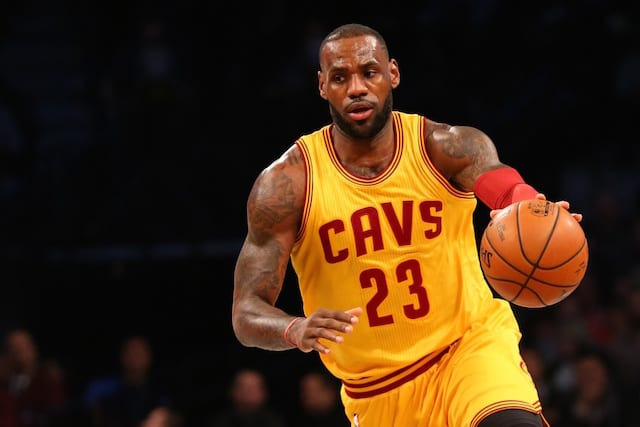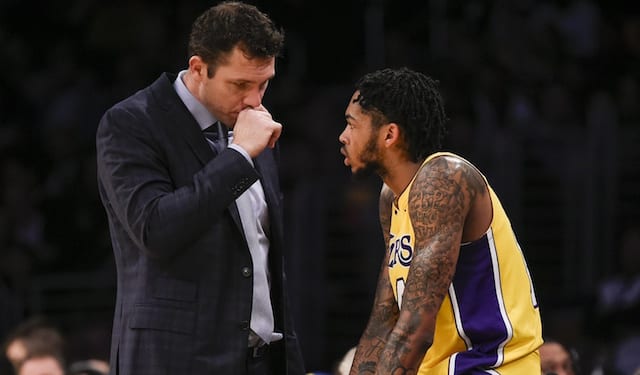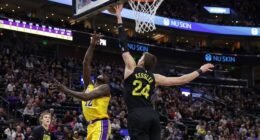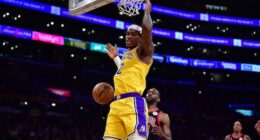
After Earl Clark had a breakout game against the San Antonio Spurs last week, I wrote an article detailing how his emergence can significantly bolster the Lakers going forward. In the article, I also softened my stance on Pau Gasol having to start ballgames. However, I once again stressed that Gasol’s half-court game is a necessary factor for the Lakers to succeed this season for a number of reasons.
With Gasol’s recent return to the lineup, I now feel that regardless of who starts or comes off the bench, the Lakers have multiple options in the front court and can even efficiently utilize all of them.
I truly feel that Earl Clark has added a dimension to the Lakers that helps the team blend together and has even enabled other players to play more naturally and seamlessly.
Let’s take a look at the impact he’s had so far, and the impact he can have going forward:
Lakers Can Play Bigger
One area in which Earl Clark’s emergence can positively impact the Lakers is allowing the Lakers to play bigger. It’s no secret that over the seasons size has been the Lakers’ biggest asset, and it still is–regardless of whether it was being utilized or not. Even with Jordan Hill out of the lineup, the Lakers are far more deep on the front lines than they are in the back court.
What Clark’s presence has done for the Lakers is allow them to play more “big” players at once. Previously, you would rarely see Jordan Hill on the court with Antawn Jamison at the same time, unless Hill was playing at the center position. Additionally, if they were out on the floor together (with Jamison playing at the small forward position), it didn’t work out too well, particularly on defense. Similarly, playing Antawn Jamison, Pau Gasol, and Dwight Howard together was even more of a defensive liability.
Simply put, Antawn Jamison could only be effective in his natural power forward position, and was often left on the bench in favor of a more defensive-minded Jordan Hill.
However, Earl Clark has changed some of this. Clark is a combo-forward–if you will–and even used to play the guard position when younger. His versatility on defense is particularly of great importance here, though. Clark can match up with taller, stronger forwards and battle them for rebounds, but can also match many smaller forwards and even some guards with his foot speed and length.
This allows he and Antawn Jamison or he and Metta World Peace to constantly switch on players defensively, and virtually become interchangeable offensively when out on the floor together.
All three forwards (World Peace, Jamison and Clark) like to play along the perimeter as well as in the post, so it can work out beautifully; and so far, it has.
That particular factor also allows for the Lakers’ bigger players to get more minutes.
“Bigger” Minutes
Effectively, Clark allows the Lakers to utilize more of their best players–who are front-court players–at the same time, instead of having to choose which one will be the better match-up on any given night.
Here’s a look at the average minutes of Metta World Peace, Antawn Jamison, and Earl Clark during the four-game stretch (which began in San Antonio) in which Earl Clark emerged with Pau Gasol sidelined:
- Metta World Peace – 33:14
- Antawn Jamison – 29:43
- Earl Clark – 31:12
Just for fun, let’s look at each player’s average stat line for that four-game stretch as well:
- Metta World Peace: 13.8 points, 5.3 rebounds, 3.0 steals and 1.5 assists
- Antawn Jamison: 13.3 points, 7.5 rebounds, 2.3 assists and 1.3 steals
- Earl Clark: 12.8 points, 10.3 rebounds, 3.5 assists, and 1.8 blocks
Those numbers are quite evenly matched, and really seem to complement each other. Additionally, the production between the three allows for Mike D’Antoni to have almost guaranteed production between his three forwards.
As for the minutes, the averages total just about 94 minutes–which is almost the amount of total minutes available for the two forward positions (96 minutes). Averaged out, that’s 20.0 points, 11.6 rebounds and 4.4 assists split between each forward position, which is outstanding!
Obviously, those numbers likely won’t remain the same, but keep in mind, they were averaged against the San Antonio Spurs and Oklahoma City Thunder along with the Cleveland Cavaliers and Milwaukee Bucks–which is a solid variety of opponents.
Now, let’s take a look at how the rotation can work with Gasol back in the lineup.
Next Page: What Happens With Gasol Back?






